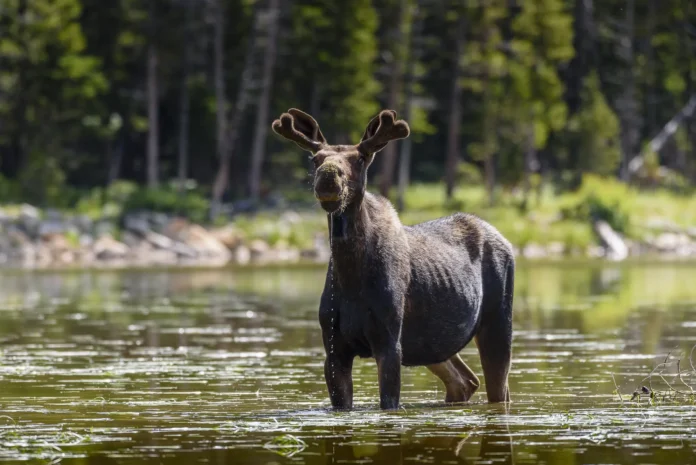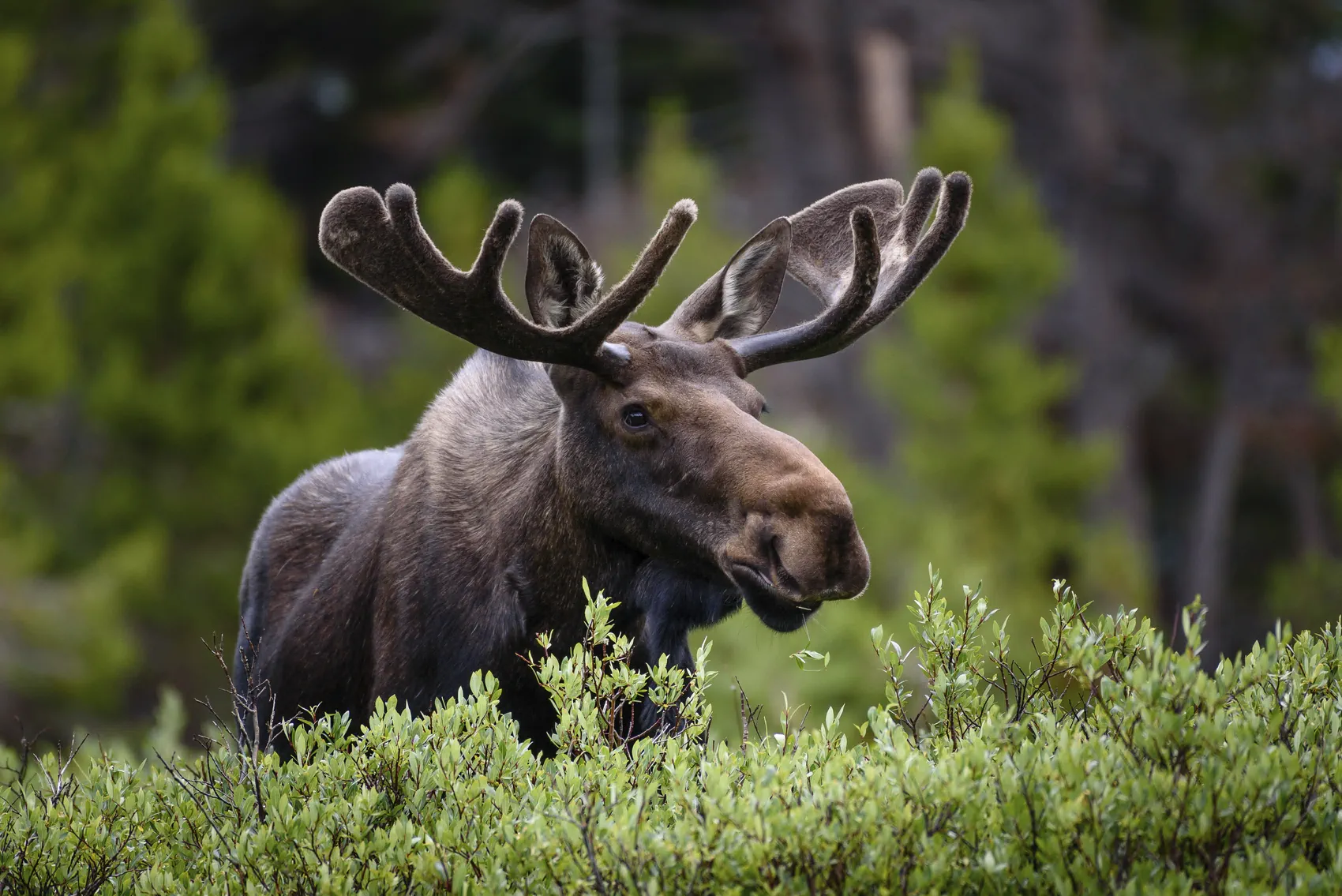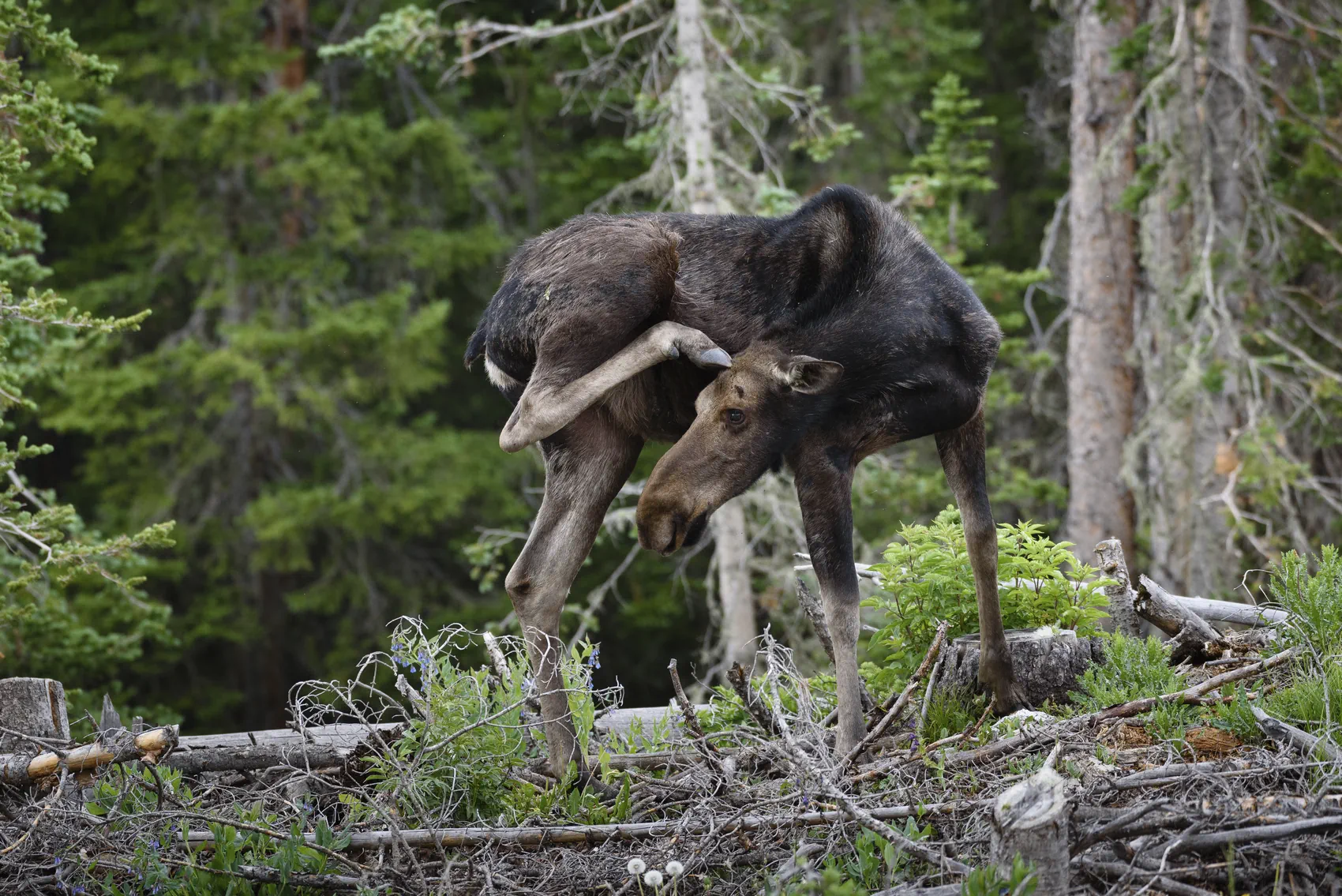Moose are not ancient residents of Colorado. Unlike elk or mule deer, they weren’t here when settlers pushed west, and they weren’t part of the Rocky Mountain landscape that Indigenous peoples hunted and managed for centuries. Colorado Parks and Wildlife released the first moose into North Park in 1978. More followed in the 1980s and early 1990s, with transplants from Wyoming and Utah.
Those early introductions thrived. Within a generation, moose were firmly rooted in the willow-choked valleys of Jackson County, expanding down the Laramie River Valley, across the Continental Divide into the Kawuneeche Valley of Rocky Mountain National Park, and even wandering into foothill towns. Today, spotting a bull with its sweeping antlers against the skyline has become a hallmark experience for tourists and residents alike.
That success story, however, is colliding with a force larger than any wildlife agency: climate change.
Biology Built for the Cold
Everything about a moose speaks to cold survival. Their hulking bodies conserve heat. Their dense, hollow coats insulate even in bitter wind. Long legs allow them to stride through deep snow and wade rivers where willows grow thick.
But this physiology becomes a burden when summer heat builds. Research across North America shows moose begin to suffer heat stress at temperatures as low as 55–60°F. In Colorado’s high valleys, where summer days now routinely break into the 70s and 80s, that means long stretches of discomfort.
Moose adapt in predictable ways: they bed down in shade, stand belly-deep in rivers, or shift feeding into the cool hours of night. Each coping behavior comes at a cost. Less time foraging means less fat laid down before winter, and cows under stress often wean lighter calves.
Parasites on the Horizon
Heat isn’t the only climate-linked threat. Longer autumns and later snowpack allow winter ticks to thrive. In the Northeast, these parasites have devastated moose herds—thousands of ticks clinging to a single animal, draining blood, weakening calves until they cannot survive winter.
Colorado hasn’t yet faced the same catastrophic outbreaks, but the conditions that fuel them—extended falls, delayed snow, warmer temperatures—are creeping into the Rockies. Biologists keep a wary eye on this slow-moving hazard, knowing it could reshape herd health in a single decade.
The Willow Connection
Moose and willows are inseparable. More than 90% of their summer diet comes from willow shoots, bolstered by aquatic plants and occasional forbs. In winter, they strip bark and chew on aspen, but without lush willow stands, herds wither.
Willow is more than food; it’s part of a system. Beavers use willow for dams, and those dams create wetlands. Wetlands hold water longer into the season, keeping willow alive. It’s a loop of water, wood, and wildlife.
In northern Colorado, that loop is breaking. Decades of heavy browsing—by both elk and moose—have left willows stunted. Hydrologic changes compound the damage: earlier runoff flushes streams before willows leaf out; hotter summers dry soils before roots can recharge. Beaver colonies collapse when willow is scarce, and with them goes the natural water storage they provide.
In the Kawuneeche Valley of Rocky Mountain National Park, the transformation is stark. Where tall willow once shaded beaver ponds, open grass now spreads across dry ground. What was once a layered wetland system is flattening into meadow.
Drought, Fire, and the New West
Add drought to the mix, and the outlook tightens further. Colorado’s high valleys are warming faster than the global average, and snowpack is less reliable. When snow melts early, spring flushes through streams before plants can absorb it. By late July, channels are often reduced to trickles, even in basins once considered water-rich.
Wildfire is another stressor. Though moose can survive fire by moving into unburned drainages, the long-term effects reshape their habitat. Fires clear shade, alter snow capture, and change the balance of plant species. In some areas, burns may spark willow regrowth, but without consistent water, those shoots die back before reaching useful height.
Managing Moose in a Changing Climate
Wildlife managers now face a paradox. The animals they worked so hard to establish are doing well numerically, but the very habitat that sustains them is in flux.
Protecting Cold Refuges
Dense conifer stands, north-facing slopes, and riparian corridors are natural cool zones. Protecting and connecting these refuges allows moose to escape midday heat without abandoning forage altogether.
Restoring Hydrology
Some of the most promising work involves beaver-based restoration. By reintroducing beavers, building “beaver dam analogs,” or re-wetting floodplains, managers can slow water loss and revive willow. Fencing key stands to protect them from browsing until they reach height has shown success in test plots.
Monitoring Parasites
Early detection of winter tick infestations is essential. Biologists track calves in spring to see how many survive, and they necropsy animals to check for parasite loads. These data points may provide the first warnings of an outbreak.
Human Encounters
As moose expand into the foothills, conflicts with people rise. Moose are not predators, but they are unpredictable. Cows with calves and bulls in rut can charge with little warning. Wildlife officers in Boulder and Fort Collins now regularly relocate young bulls that wander into neighborhoods—both to protect people and to save the animals from being destroyed.
The Human Lens
Moose aren’t just animals on a landscape—they’re part of the culture of northern Colorado. Hikers cherish the chance to spot them along the Colorado River headwaters. Hunters pay for limited moose tags, and those license fees funnel directly back into wildlife management. Photographers line roadsides in autumn, waiting for the perfect shot of a bull in velvet or a cow leading calves across a stream.
That cultural value cuts both ways. As climate stress mounts, expect more public pressure on land managers to “save the moose.” Yet saving them isn’t as simple as cutting tags or adding more animals. It requires landscape-scale work: restoring hydrology, buffering wetlands, and planning for long-term water security.
What the Future Holds
The question isn’t whether moose will remain in Colorado—they will. The question is at what density, in what places, and with what compromises.
Some valleys, like North Park, may hold stable herds thanks to broad wetlands and cooler nights. Others, like the Kawuneeche, may see declines if willow and water continue to vanish. Climate models suggest hotter, drier summers are the new normal. That means managers and communities must prepare for lower carrying capacity—fewer moose per valley—even if overall range remains wide.
The lesson from the past 40 years is clear: moose are resilient, but not invincible. They can adapt to some stressors, wander into new ranges, and exploit novel habitats. But they cannot outpace the fundamental shifts in water and temperature that shape the Rockies.
In the quiet of dawn, when steam rises from the Colorado River and willows catch the first light, moose still move like shadows. They are as much a part of today’s Rockies as elk bugling in September or bighorns on a cliff. Yet they are living on the edge of a shifting climate.
To keep them here, Colorado will need more than nostalgia and admiration. It will need active stewardship of water, willows, and wetlands. The work is complex, and the odds tighten with every dry year, but the payoff is immense: herds of moose still ghosting through the valleys of northern Colorado, long after today’s heat waves are old history.
References and research
- Bear Butte Geology and Age (Eocene Laccolith)
- Elevation, Views, and Park Overview
- Trail Distance and Hiking Information
- Sacred Status, Names, and Ongoing Practices
- Rocky Mountain National Park Moose Overview
- Colorado Parks & Wildlife Moose History and Management
- Studies on Moose Heat Stress Thresholds
- Riparian Decline, Willow Loss, and Climate Impacts
- Moose Encounters and Relocations on the Front Range









